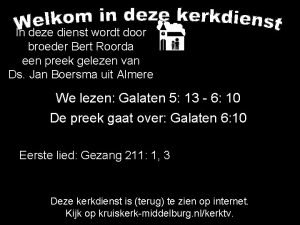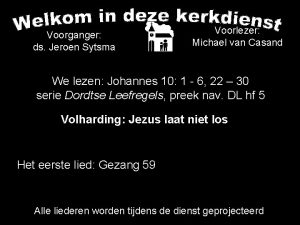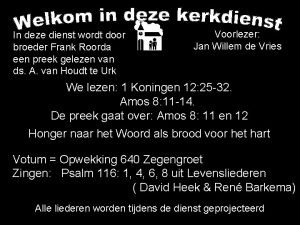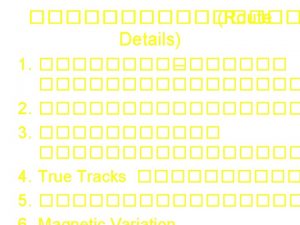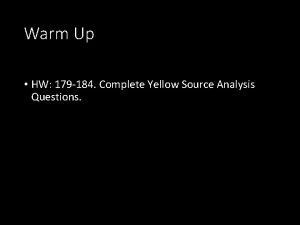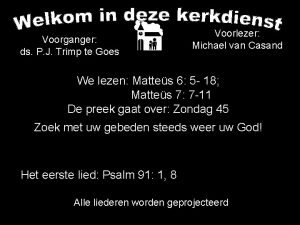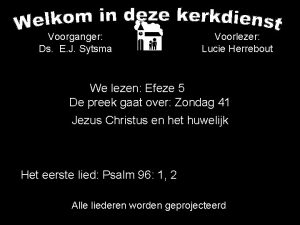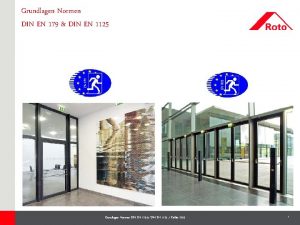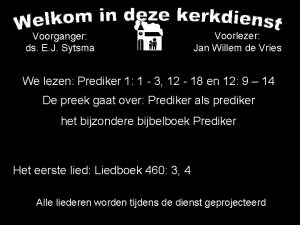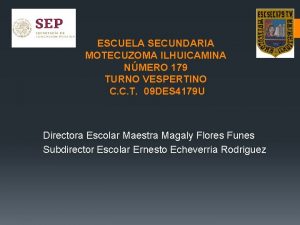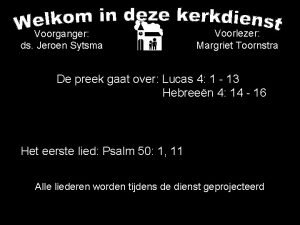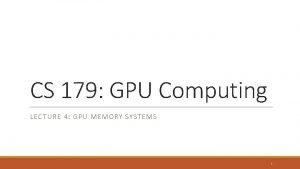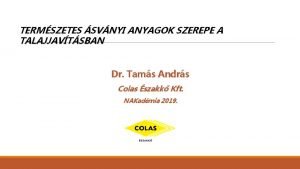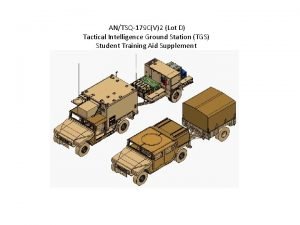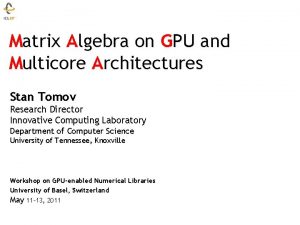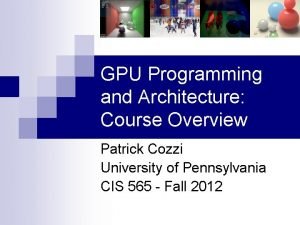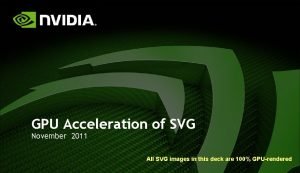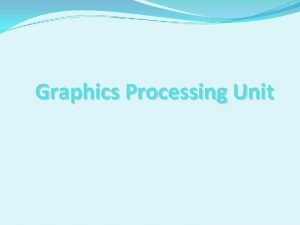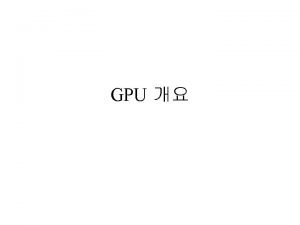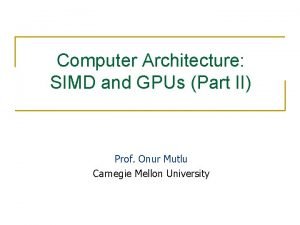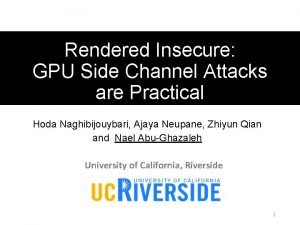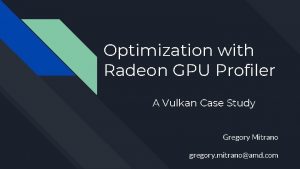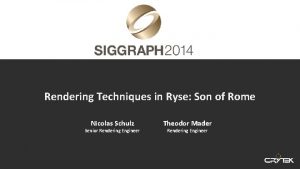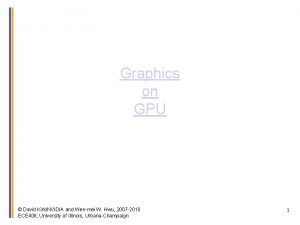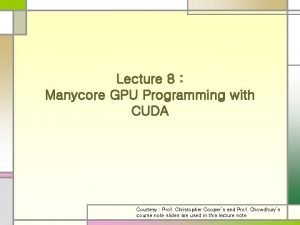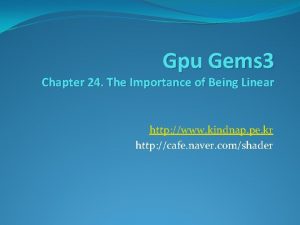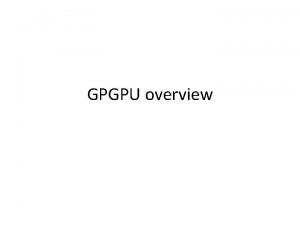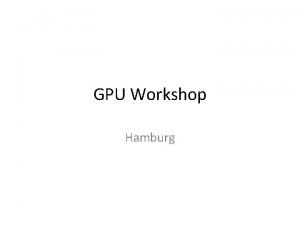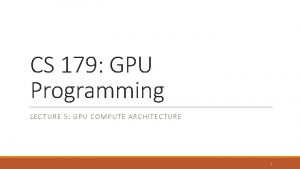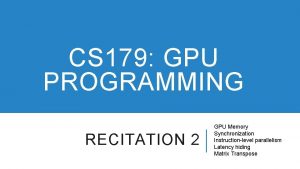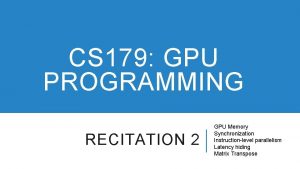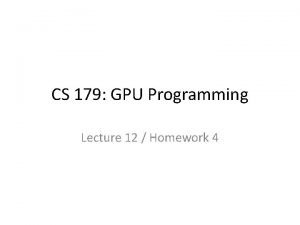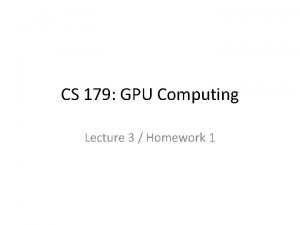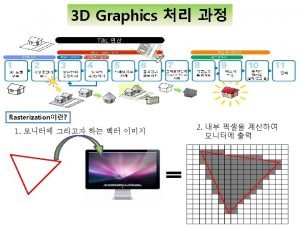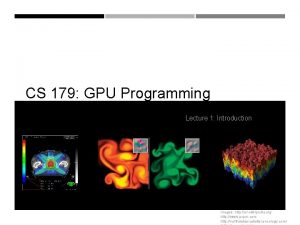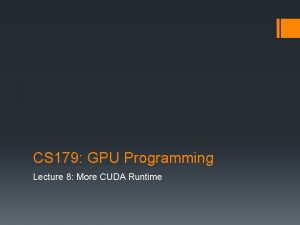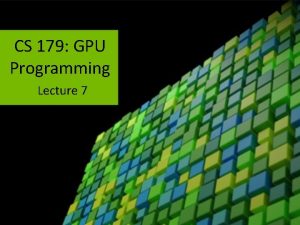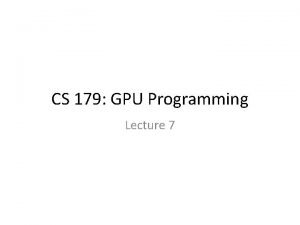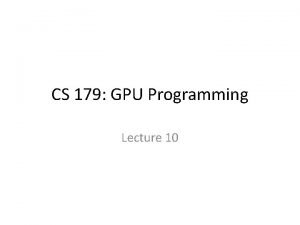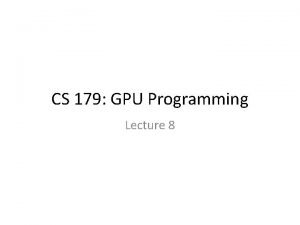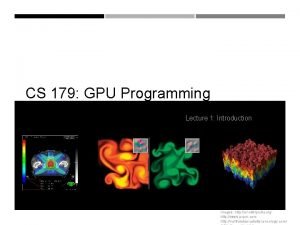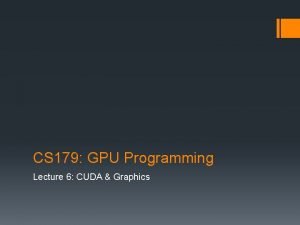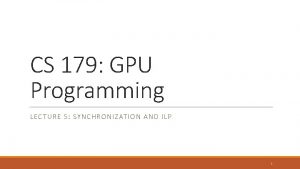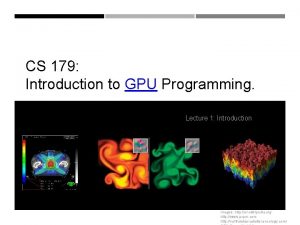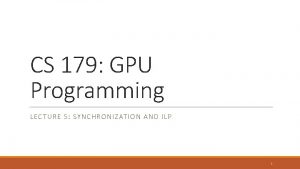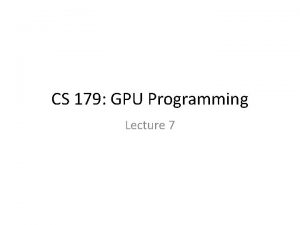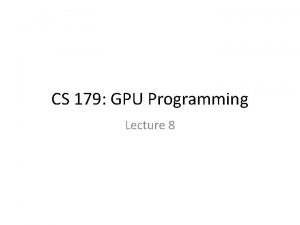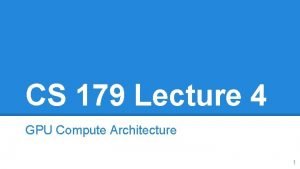CS 179 GPU Programming Lecture 12 Homework 4























































- Slides: 55

CS 179: GPU Programming Lecture 12 / Homework 4

Breadth-First Search • Given source vertex S: – Find min. #edges to reach every vertex from S – (Assume source is vertex 0) • Sequential pseudocode: let Q be a queue Q. enqueue(source) label source as discovered source. value <- 0 while Q is not empty v ← Q. dequeue() for all edges from v to w in G. adjacent. Edges(v): if w is not labeled as discovered Q. enqueue(w) label w as discovered, w. value <- v. value + 1 0 1 2 3

Alternate BFS algorithm • New sequential pseudocode: Input: Va, Ea, source (graph in “compact adjacency list” format) Create frontier (F), visited array (X), cost array (C) F <- (all false) X <- (all false) C <- (all infinity) F[source] <- true C[source] <- 0 while F is not all false: Parallelizable! for 0 ≤ i < |Va|: if F[i] is true: F[i] <- false X[i] <- true for Ea[Va[i]] ≤ j < Ea[Va[i+1]]: if X[j] is false: C[j] <- C[i] + 1 F[j] <- true

GPU-accelerated BFS • CPU-side pseudocode: Input: Va, Ea, source (graph in “compact adjacency list” format) Create frontier (F), visited array (X), cost array (C) F <- (all false) X <- (all false) C <- (all infinity) F[source] <- true C[source] <- 0 while F is not all false: call GPU kernel( F, X, C, Va, Ea ) Can represent boolean values as integers • GPU-side kernel pseudocode: if F[thread. Id] is true: F[thread. Id] <- false X[thread. Id] <- true for Ea[Va[thread. Id]] ≤ j < Ea[Va[thread. Id + 1]]: if X[j] is false: C[j] <- C[thread. Id] + 1 F[j] <- true

Texture Memory (and co-stars) • Another type of memory system, featuring: – Spatially-cached read-only access – Avoid coalescing worries – Interpolation – (Other) fixed-function capabilities – Graphics interoperability

X-ray CT Reconstruction

Medical Imaging • See inside people! – Critically important in medicine today "Saddle. PE" by James Heilman, MD - Own work. Licensed under CC BY-SA 3. 0 via Wikimedia Commons - http: //commons. wikimedia. org/wiki/File: Saddle. PE. PNG#/media/File: Saddle. PE. PNG "PAPVR". Licensed under CC BY 3. 0 via Wikipedia - http: //en. wikipedia. org/wiki/File: PAPVR. gif#/media/File: PAPVR. gif

X-ray imaging (Radiography) • “Algorithm”: – Generate electromagnetic radiation – Measure radiation at the “camera” • Certain tissues are more “opaque” to X-rays • Like photography! "Coude fp" by MB - Collection personnelle. Licensed under CC BY-SA 2. 5 via Wikimedia Commons - http: //commons. wikimedia. org/wiki/File: Coude_fp. PNG#/media/File: Coude_fp. PNG http: //www. imaginis. com/xray/how-does-x-ray-imaginig-work

Radiography limitations • Generates 2 D image of 3 D body • What if we want a “slice” of 3 D body? – Goal: 3 D reconstruction! (from multiple slices) "Coude fp" by MB - Collection personnelle. Licensed under CC BY-SA 2. 5 via Wikimedia Commons - http: //commons. wikimedia. org/wiki/File: Coude_fp. PNG#/media/File: Coude_fp. PNG "Computed tomography of human brain - large" by Department of Radiology, Uppsala University Hospital. Uploaded by Mikael Häggström. - Radiology, Uppsala University Hospital. Brain supplied by Mikael Häggström. It was taken Mars 23, 2007. Licensed under CC 0 via Wikimedia Commons - http: //commons. wikimedia. org/wiki/File: Computed_tomography_of_human_brain__large. png#/media/File: Computed_tomography_of_human_brain_-_large. png vs.

X-ray Computed Tomography (CT) http: //www. cancer. gov/ "Bonereconstruction" by Original uploader was Zgyorfi at en. wikipedia - Transferred from en. wikipedia; transferred to Commons by User: Common Good using Commons. Helper. . Licensed under CC BY-SA 3. 0 via Wikimedia Commons - http: //commons. wikimedia. org/wiki/File: Bonereconstruction. jpg#/media/File: Bonereconstruction. jpg

X-ray Computed Tomography (CT) • Generate 2 D “slice” using 3 D imaging – New imaging possibilities! • Reconstruction less straightforward

X-ray Computed Tomography (CT) • “Algorithm” (per-slice): – Take *lots* of pictures at different angles • Each “picture” is a 1 -D line – Reconstruct the many 1 -D pictures into a 2 -D image • Harder, more computationally intensive! – 3 D reconstruction requires multiple slices http: //www. thefullwiki. org/Basic_Physics_of_Nuclear_ Medicine/X-Ray_CT_in_Nuclear_Medicine

Mathematical Details •

Mathematical Details •

Mathematical Details •

Mathematical Details •

Mathematical Details •

X-ray Computed Tomography (CT) •

X-ray CT Reconstruction •

Reconstruction X-ray detector … X-ray emitter

Reconstruction Different θ’s X-ray detector … X-ray emitter

Reconstruction Different θ’s Each location on detector: Corresponds to multiple x 0’s X-ray detector … X-ray emitter

X-ray CT Reconstruction •

Imperfect Reconstruction 10 angles of imaging 200 angles of imaging

Reconstruction •

Reconstruction Different θ’s Each location on detector: Corresponds to multiple x 0’s X-ray detector … X-ray emitter

Geometry Details • For x 0, need to find: – At each θ, which radiation measurement corresponds to the line passing through x 0?

Geometry Details Detector “The patient” (slice) Emitter

Geometry Details (x 0, y 0) Detector “The patient” (slice) θ Emitter

Geometry Details Distance from sinogram centerline d (x 0, y 0) Detector “The patient” (slice) θ Emitter

Geometry Details Distance from sinogram centerline d (x 0, y 0) Detector θ “The patient” (slice) Radiation slope: m = -cos(θ)/sin(θ) Emitter

Geometry Details Distance from sinogram centerline d (x 0, y 0) Perpendicular slope: q = -1/m (correction) Detector Radiation slope: m = -cos(θ)/sin(θ) θ θ Emitter

Geometry Details Distance from sinogram centerline d (x 0, y 0) Find intersection point (xi, yi) Then d 2 = xi 2 + yi 2 Perpendicular slope: q = -1/m (correction) Detector θ Radiation slope: m = -cos(θ)/sin(θ) d θ Emitter

Intersection point • Corrections

Intersection point • Corrections

Geometry Details Distance from sinogram centerline d (x 0, y 0) Find intersection point (xi, yi) Then d 2 = xi 2 + yi 2 Perpendicular slope: q = -1/m (correction) Detector θ Radiation slope: m = -cos(θ)/sin(θ) d θ Emitter

Sequential pseudocode (input: X-ray sinogram): (allocate output image) for all y in image: for all x in image: for all theta in sinogram: Clarification: Remember not calculate m from theta to confuse geometric x, y with calculate x_i, y_i from m, -1/m calculate d from x_i, y_i pixel x, y! image[x, y] += sinogram[theta, “distance”] (0, 0) geometrically is the center pixel of the image, and (0, 0) in pixel coordinates is the upper left hand corner. Image is indexed row-wise Correction/clarification: • d is the distance from the center of the sinogram – remember to center index appropriately • Use –d instead of d as appropriate (when -1/m > 0 and x_i < 0, or if -1/m < 0 and x_i > 0

Sequential pseudocode (input: X-ray sinogram): (allocate output image) Parallelizable! Inside loop depends only on x, y, theta for all y in image: for all x in image: for all theta in sinogram: calculate m from theta calculate x_i, y_i from m, -1/m calculate d from x_i, y_i (corrections/clarification – image[x, y] += sinogram[theta, “distance”] see slide 37)

Sequential pseudocode (input: X-ray sinogram): (allocate output image) For this assignment, only parallelize w/r/to x, y (provides lots of parallelization already, other issues) for all y in image: for all x in image: for all theta in sinogram: calculate m from theta calculate x_i, y_i from m, -1/m calculate d from x_i, y_i (corrections/clarification – image[x, y] += sinogram[theta, “distance”] see slide 37)

Cautionary notes • y in an image is opposite of y geometrically! – (Graphics/computing convention) • Edge cases (divide-by-0): – θ = 0: • d = x 0 – θ = π/2: • d = y 0

Almost a good reconstruction! Original Reconstruction

Almost a good reconstruction! • “Backprojection blur” – Similar to low-pass property of SMA (Week 1) – We need an “anti-blur”! (opposite of Homework 1)

Almost a good reconstruction! • Solution: – A “high-pass filter” – We can get frequency info in parallelizable manner! • (FFT, Week 3)

Almost a good reconstruction! • Solution: – A “high-pass filter” – We can get frequency info in parallelizable manner! • (FFT, Week 3)

High-pass filtering • Instead of filtering on image (2 D HPF): – Filter on sinogram! (1 D HPF) • (Equivalent reconstruction by linearity) – Use cu. FFT batch feature! • We’ll use a “ramp filter” – Retained amplitude is linear function of frequency – (!! Subject to change)

Almost a good reconstruction! • CPU-side: (input: X-ray sinogram): calculate FFT on sinogram using cu. FFT call filter. Kernel on freq-domain data Calculate IFFT on freq-domain data -> get new sinogram • GPU-side: filter. Kernel: Select specific freq-amplitude based on thread ID Get new amplitude from ramp equation

GPU Hardware • Non-coalesced access! – Sinogram 0, index ~d 0 – Sinogram 1, index ~d 1 – Sinogram 2, index ~d 2 –… …

GPU Hardware • Non-coalesced access! – Sinogram 0, index ~d 0 – Sinogram 1, index ~d 1 – Sinogram 2, index ~d 2 –… • However: – Accesses are 2 D spatially local! …

GPU Hardware • Solution: – Cache sinogram in texture memory! • Read-only (un-modified once we load it) • Ignore coalescing • 2 D spatial caching! …

Summary/pseudocode (input: X-ray sinogram) Filter sinogram (Slide 46) Set up 2 D texture cache on sinogram (Lecture 10): Copy to CUDA array (2 D) Set addressing mode (clamp) Set filter mode (linear, but won’t matter) Set no normalization Bind texture to sinogram Calculate image backprojection (parallelize Slide 39) • Result: 200 -250 x speedup! (or more)

• Result: 200 -250 x speedup! (or more)

Admin • This topic is harder than before! – Lots of information – I may have missed something – If there’s anything unclear, let us know • I can (and likely will) make additional slides/explanatory materials

Admin • Set 4 not out yet – Should be by Saturday night – (Some details in slides may change due to performance considerations) • (Will correct and notify as necessary) – Due date: Friday (5/1), 11: 59 PM – Office hours: (same as this week) • Monday, 9 -11 PM • Tuesday, 7 -9 PM • Thursday, 8 -10 PM

Admin • C/CUDA code should work on all machines • Pre/post-processing: – Python scripts preprocess. py, postprocess. py • (To run Python scripts: “python <script>. py”) – Either: • Use haru • Install python, (optionally pip) -> numpy, scipy, matplotlib, scikit-image

Resources • Imaging methods: – X-Ray CT in Nuclear Medicine – CT Image Reconstruction (Peters, at AAPM) – Elements of Modern Signal Processing (Candes, at Stanford) • Proof that our algorithm works!
 01:640:244 lecture notes - lecture 15: plat, idah, farad
01:640:244 lecture notes - lecture 15: plat, idah, farad Alitteration definition
Alitteration definition Homework oh homework i hate you you stink
Homework oh homework i hate you you stink Literal language example
Literal language example Jack prelutsky homework oh homework
Jack prelutsky homework oh homework Homework oh homework jack prelutsky
Homework oh homework jack prelutsky Homework oh homework i hate you you stink
Homework oh homework i hate you you stink C programming lecture
C programming lecture Definisi integer
Definisi integer Greedy programming vs dynamic programming
Greedy programming vs dynamic programming System programming
System programming Integer programming vs linear programming
Integer programming vs linear programming Perbedaan linear programming dan integer programming
Perbedaan linear programming dan integer programming Gezang 179
Gezang 179 Jeroen sytsma
Jeroen sytsma Himno 179
Himno 179 Frank roorda
Frank roorda 0-179 altitude
0-179 altitude Hw-179
Hw-179 Gezang 427 liedboek
Gezang 427 liedboek Qpr enterprise architect
Qpr enterprise architect Gezang 179
Gezang 179 Beschlag en 179
Beschlag en 179 Hazmat table
Hazmat table Liedboek 460
Liedboek 460 Gezang 179
Gezang 179 Gezang 179
Gezang 179 Contoh ayat memanfaatkan
Contoh ayat memanfaatkan Signing naturally 4.1 minidialogue 3
Signing naturally 4.1 minidialogue 3 Secundaria 179
Secundaria 179 Gezang 179
Gezang 179 Cs 179
Cs 179 Jhs 179
Jhs 179 791-179-455
791-179-455 Prosessikaavio pohja
Prosessikaavio pohja Tactical intelligence ground station
Tactical intelligence ground station Gpu stan
Gpu stan Gpu germany
Gpu germany Githubn
Githubn Gpu svg
Gpu svg What is gpu
What is gpu Gpu
Gpu Simd vs gpu
Simd vs gpu Rendered insecure: gpu side channel attacks are practical
Rendered insecure: gpu side channel attacks are practical Radeon developer panel
Radeon developer panel Alea gpu
Alea gpu Ryse son of rome map
Ryse son of rome map Gpu
Gpu Adobe certified gpu
Adobe certified gpu Gpu
Gpu Cache coherence for gpu architectures
Cache coherence for gpu architectures Inkscape gpu acceleration
Inkscape gpu acceleration Gpu gems 4
Gpu gems 4 Gpugpu
Gpugpu Atlas gpu
Atlas gpu Inkscape gpu acceleration
Inkscape gpu acceleration













